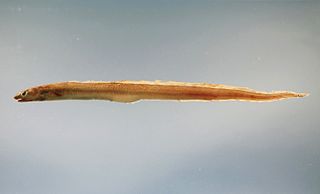 W
WThe American conger is a species of eel in the family Congridae. Other common names for this fish include conger, dog eel, poison eel and sea eel. It is a marine fish with a widespread distribution in the Western Atlantic from Cape Cod in Massachusetts to northeastern Florida in United States and the northern Gulf of Mexico, and is also reported from near the mid-Atlantic island of St. Helena and off the coast of Nova Scotia in Canada. Dark grayish color, it can grow to about 6.5 feet (2.0 m) long and weigh more than 40 kg (88 lb).
 W
WThe American gizzard shad, also known as the mud shad, is a member of the herring family of fish, and is native to large swaths of fresh and brackish waters of the United States of America. The adult has a deep body, with a silvery-green coloration above fading to plain silver below. The gizzard shad commonly resides in freshwater lakes, reservoirs, rivers, and streams, but can reside in brackish waters, as it does on the Atlantic coast of the United States. Their range is across most of the continental United States, although they typically go no further north than New York and no further west than New Mexico. They are large parts of many of the ecosystems they inhabit, and can drive changes in phyto- and zooplankton, thereby indirectly affecting other planktivorous fishes. The gizzard shad has been widely used as a food source for game fish, with varied success in management and effectiveness.
 W
WThe Atlantic thread herring is a herring-like fish in the family Clupeidae.
 W
WThe barndoor skate is a species of marine cartilaginous fish in the skate family Rajidae of the order Rajiformes. It is native to the northwestern Atlantic Ocean, and is found from the Grand Banks of Newfoundland and the southern side of the Gulf of St. Lawrence south to North Carolina. The fish is one of the largest skates found in the North Atlantic Ocean, reaching lengths up to 1.5 m (5 ft). It is carnivorous, feeding on invertebrates and other fish found near the sea floor.
 W
WThe chain pickerel is a species of freshwater fish in the pike family of order Esociformes. The chain pickerel and the American pickerel belong to the Esox genus of pike.
 W
WThe channel catfish is North America's most numerous catfish species. It is the official fish of Kansas, Missouri, Iowa, Nebraska, and Tennessee, and is informally referred to as a "channel cat". In the United States, they are the most fished catfish species with around 8 million anglers targeting them per year. The popularity of channel catfish for food has contributed to the rapid expansion of aquaculture of this species in the United States. It has also been widely introduced in Europe, Asia and South America, and it is legally considered an invasive species in many countries.
 W
WThe common logperch, sometimes simply known as the logperch, is a species of freshwater ray-finned fish, a darter from the subfamily Etheostomatinae, part of the family Percidae, which also contains the perches, ruffes and pikeperches. Like other logperches, it has the typical vertical barring along the flank and a subterminal mouth.
 W
WCoregonus artedi, commonly known as the cisco, is a North American species of freshwater whitefish in the family Salmonidae. The number of species and definition of species limits in North American ciscoes is a matter of debate. Accordingly, Coregonus artedi may refer either in a narrow sense to one of the several types of cisco found e.g. in the Great Lakes, or in a broad sense to the complex of all ciscoes in continental North American lakes, Coregonus artedi sensu lato.
 W
WCoregonus gutturosus, the Lake Constance whitefish, is an extinct species of whitefish in the salmon family Salmonidae. It was formerly found only in deep areas of Lake Constance in the Alps.
 W
WThe dusky shark is a species of requiem shark, in the family Carcharhinidae, occurring in tropical and warm-temperate continental seas worldwide. A generalist apex predator, the dusky shark can be found from the coast to the outer continental shelf and adjacent pelagic waters, and has been recorded from a depth of 400 m (1,300 ft). Populations migrate seasonally towards the poles in the summer and towards the equator in the winter, traveling hundreds to thousands of kilometers. One of the largest members of its genus, the dusky shark reaches 4.2 m (14 ft) in length and 347 kg (765 lb) in weight. It has a slender, streamlined body and can be identified by its short round snout, long sickle-shaped pectoral fins, ridge between the first and second dorsal fins, and faintly marked fins.
 W
WThe emerald shiner is one of hundreds of small, silvery, slender fish species known as shiners. The identifying characteristic of the emerald shiner is the silvery emerald color on its sides. It can grow to 3.5 inches in length and is found across North America from Canada to the Gulf of Mexico, commonly in large, deep lakes and rivers, though sometimes in smaller bodies of water as well. It feeds on small organisms such as zooplankton and insects, congregating in large groups near the surface of the water. It is a quite common fish and is often used as a bait fish.
 W
WThe flathead catfish, also called by several common names including mudcat or shovelhead cat, is a large species of North American freshwater catfish in the family Ictaluridae. It is the only species of the genus Pylodictis. Ranging from the lower Great Lakes region to northern Mexico, it has been widely introduced and is an invasive species in some areas. The closest living relative of the flathead catfish is the much smaller widemouth blindcat, Satan eurystomus.
 W
WThe golden redhorse, Moxostoma erythrurum, is a species of freshwater fish endemic to Ontario and Manitoba in Canada and the Midwestern, southern, and eastern United States. It lives in calm, often silty or sandy waters in streams, small to large rivers, and lakes.
 W
WHiodon tergisus, the mooneye, is a freshwater fish that is widespread across eastern North America.
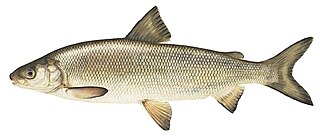 W
WThe lake whitefish is a species of freshwater whitefish from North America. Lake whitefish are found throughout much of Canada and parts of the northern United States, including all of the Great Lakes. The lake whitefish is sometimes referred to as a "humpback" fish due to the small size of the head in relation to the length of the body. It is a valuable commercial fish, and also occasionally taken by sport fishermen. Smoked, refrigerated, vacuum-packed lake whitefish fillets are available in North American grocery stores. Other vernacular names used for this fish include Otsego bass, Sault whitefish, gizzard fish, common whitefish, eastern whitefish, Great Lakes whitefish, humpback whitefish, inland whitefish and whitefish.
 W
WMerluccius albidus, sometimes known as the offshore hake, offshore silver hake, or offshore whiting, is a species of fish in the family Merlucciidae. It is found on the outer (offshore) continental shelf at depths of 70–1,170 m (230–3,840 ft) in the west Atlantic, ranging from New England to French Guiana. It reaches 70 cm (28 in) in length and 4.1 kg (9.0 lb) in weight.
 W
WMonacanthus ciliatus, commonly known as the fringed filefish, the cuckold or the leather-fish, is a species of bony fish commonly found in shallow water in the western Atlantic Ocean, the Caribbean Sea and the Gulf of Mexico.
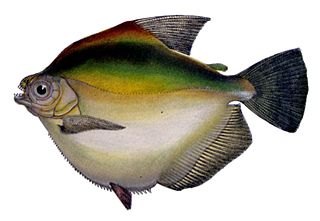 W
WMylossoma duriventre, the silver mylossoma, is a species of freshwater serrasalmid fish endemic to tropical and subtropical South America. It grows to a maximum length of about 25 cm (10 in) and a weight of 1 kg (2.2 lb). It is the subject of a local fishery, being known as palu in Brazil and palometa in Venezuela.
 W
WThe pancake batfish belongs to the batfish family Ogcocephalidae. Their distributrition includes western Atlantic, North Carolina, northern Gulf of Mexico to northern South America. They inhabit a subtropical, sandy, reef-associated, and 45–820 m deep environment.
 W
WPiaractus brachypomus, the pirapitinga, is a large species of pacu, a close relative of piranhas and silver dollars, in the serrasalmid family. It is native to the Amazon basin in tropical South America, but it formerly included populations in the Orinoco, only described in 2019 as a separate species, P. orinoquensis. Additionally, P. brachypomus is widely farmed and has been introduced to other regions. In South Florida they are invasive in rivers, canals or lakes.
 W
WThe sand devil or Atlantic angel shark is a species of angelshark, family Squatinidae, native to the northwestern Atlantic Ocean. It occurs off the eastern United States, in the northern Gulf of Mexico, and possibly in parts of the Caribbean Sea. This bottom-dwelling shark is found in shallow inshore waters in summer and fall, and deep offshore waters in winter and spring. The sand devil's flattened body and enlarged pectoral and pelvic fins give it a ray-like appearance. There is a band of enlarged thorns running along the middle of its back. It is gray or brown in color, with scattered small dark spots. This species reaches 1.2–1.5 m (3.9–4.9 ft) in length.
 W
WSemotilus atromaculatus, known as the creek chub or the common creek chub, is a small minnow, a freshwater fish found in the eastern US and Canada. Differing in size and color depending on origin of development, the creek chub can usually be defined by a dark brown body with a black lateral line spanning horizontally across the body. It lives primarily within streams and rivers. Creek Chubs attain lengths of 2-6 inches with larger specimens of up to 12 inches possible. The genus name Semotilus derives from the Greek word sema, and atromaculatus comes from the Latin word "black spots".
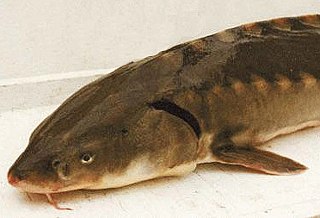 W
WThe shortnose sturgeon is a small and endangered species of North American sturgeon. The earliest remains of the species are from the Late Cretaceous Period, over 70 million years ago. Shortnose sturgeons are long-lived and slow to sexually mature. Most sturgeons are anadromous bottom-feeders, which means they migrate upstream to spawn but spend most of their lives feeding in rivers, deltas and estuaries. The shortnose sturgeon is often mistaken as a juvenile Atlantic sturgeon, because of their small size. Prior to 1973, U.S. commercial fishing records did not differentiate between the two species, both were reported as "common sturgeon", although it is believed based on sizes that the bulk of the catch was Atlantic sturgeon. The shortnose is distinguishable from the Atlantic sturgeon due to its shorter and rounder head.
 W
WThe slender-spined porcupine fish or globefish is a porcupinefish of the family Diodontidae, found in the waters of southern Australia, as far north as Port Jackson to Geraldton, Western Australia. It is most common in Port Phillip Bay and the coastal waters of Tasmania in shallow coastal waters and under manmade jettys.
 W
WThe smalleyed ray or smalleyed skate is a species of ray in the family Rajidae, the typical rays and skates, from the eastern Atlantic Ocean where it is found in tidal, coastal waters with sandy substrates.
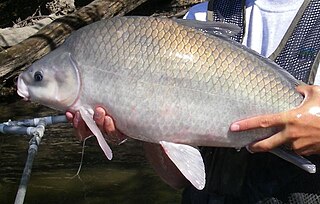 W
WThe smallmouth buffalo is a Catostomidae fish species native to the major tributaries and surrounding waters of the Mississippi River in the United States, as well as some other water systems where it has been introduced. It is a long-lived, stocky fish like its relatives the bigmouth buffalo and the black buffalo, although the smallmouth buffalo's mouth is located ventrally like other Catostomidae species, while the bigmouth buffalo's mouth is terminal and opens forward, and the smallmouth buffalo's eyes are significantly larger than those of the black buffalo. Despite being members of different scientific families, these three species superficially resemble the common carp, but an easy and notable difference is that all catostomids lack the characteristic barbels of carp.
 W
WThe tambaqui is a large species of freshwater fish in the family Serrasalmidae. It is native to tropical South America, but kept in aquaculture and introduced elsewhere. It is also known by the names black pacu, black-finned pacu, giant pacu, cachama, gamitana, and sometimes as pacu.
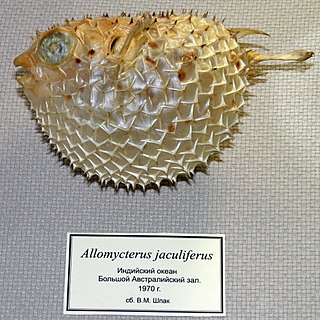 W
WTragulichthys jaculiferus also known as the longspine burrfish, is a species of porcupinefish native to the Indo-Pacific where it occurs in reef environments at depths of from 26 to 137 metres. This species grows to a length of 30 centimetres (12 in) TL. This species is the only known member of its genus.
 W
WThe walleye, also called the yellow pike or yellow pickerel, is a freshwater perciform fish native to most of Canada and to the Northern United States. It is a North American close relative of the European zander, also known as the pikeperch. The walleye is sometimes called the yellow walleye to distinguish it from the blue walleye, which is a subspecies that was once found in the southern Ontario and Quebec regions, but is now presumed extinct. However, recent genetic analysis of a preserved (frozen) 'blue walleye' sample suggests that the blue and yellow walleye were simply phenotypes within the same species and do not merit separate taxonomic classification.
 W
WThe white crappie is a freshwater fish found in North America, one of the two species of crappies. Alternate common names for the species include goldring and silver perch. USS Goldring is named for the fish. The genus name Promoxis refers to crappies' sharp operculum, while the species name annularis means 'having rings', i.e., it has vaguely vertical bars on the body.